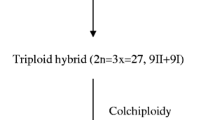Abstract
Occasion for writing this article was the appearance of two papers of Price, one concerning the occurrence of apomixis in sugar cane, the other dealing with cytological results of intra-and interspecific crosses of Saccharum. Especially in the latter he criticized Bremer's discovery of endo-duplication during megasporogenesis in Saccharum forms.
The present author formulates his stand-point by an ample discussion of endoduplication as cause of chromosome increase in Saccharum crosses. The phenomenon of parthenogenesis is treated in relation to hybridization and speciation. The author concludes that Price gives evidence of insufficient understanding of endo-duplication while also about the occurrence of parthenogenesis he cannot agree with him.
Samenvatting
Aanleiding tot het schrijven van dit zesde deel van “Problems in breeding and cytology of sugar cane” was de recente verschijning van een artikel van S. Price in “The Botanical Gazette” over de overbrenging der chromosomen aan de vrouwelijke zijde in kruisingen van S. officinarum binnen de soort en in kruisingen met andere Saccharum-soorten (14).
In dit artikel becritiseert hij de uitgebreide verhandeling over endo-duplicatie als oorzaak van vermeerdering van chromosomenaantal verschenen in 1959 in “Bibliographia Genetica”. Het blijkt uit deze kritiek, dat Price het mechanisme van endoduplicatie, door de schrijver ontdekt, slechts zeer ten dele heeft begrepen. Ook worden “citaten” gegeven, die zo verhaspeld zijn, dat ze weinig getuigen van de werkelijke inhoud van het stuk.
Het voorkomen van parthenogenese, een verschijnsel, dat bij suikerriet naar het oordeel van de schrijver en van Indiase onderzoekers niet zeldzaam is, wordt door Price beoordeeld als ten hoogste zeldzaam voorkomend, terwijl hij er zich bovendien een voorstelling van maakt, die naar het oordeel van de schrijver onjuist is.
Aangezien het hier kwesties betreft, die in verband met suikerrietveredeling van veel belang zijn, zou verschil van mening, grotendeels berustend op onjuiste interpretatie, zeker aanleiding geven tot verwarring in toekomstige suikerriet literatuur.
De schrijver heeft het daarom nodig gevonden endo-duplicatie en parthenogenese bij suikerriet nog eens uitgebreid in beschouwing te nemen, daarbij tot hypothetische gevolgtrekkingen en suggesties komend, die mogelijk van belang kunnen zijn bij de veredeling en soortsvorming van Saccharum.
Similar content being viewed by others
References
Bremer, G., 1928. Een cytologisch onderzoek der bastaarden tusschen Saccharum officinarum en Saccharum spontaneum. Archief Suikerindustrie Nederl. Indië. Mededeelingen Proefstation Java Suikerindustrie, 1928. No. 11: 565–696.
Bremer, G., 1930. Short remarks on the cytology of Saccharum. Paper Proc. Third Congr. Intern. Society of Sugar Cane Technologists. Soerabaja. 1929: 403–408.
Bremer, G., 1946. De cytologie van soortsbastaarden bij Saccharum. Vakblad voor Biologen 26: 3–10.
Bremer, G., 1948. Increase of chromosome numbers in species htbrids of Saccharum. Abstract Proc. Eighth Intern. Congress of Genetics, Stockholm 1948. Hereditas, Supplementary Volume 1949: 541.
Bremer, G., 1959. Increase of chromosome number in species-hybrids of Saccharum in relation to embryo-sac development. Bibliographia Genetica 18: 1–99.
Bremer, G., 1961. Problems in breeding and cytology of sugar cane I. A short history of sugar cane breeding; the original forms of Saccharum. Euphytica 10: 59–78.
Bremer, G., 1961. Problems in breeding and cytology of sugar cane II. The sugar cane breeding from a cytological view-point. Euphytica 10: 121–133.
Bremer, G., 1961. Problems in breeding and cytology of sugar cane III. The cytological crossing research of sugar cane. Euphytica 10: 229–243.
Bremer, G., 1961. Problems in breeding and cytology of sugar cane IV. The origin of the increase of chromosome number in species hybrids of Saccharum. Euphytica 10: 325–342.
Bremer, G., 1962. Problems in breeding and cytology of sugar cane V. Chromosome increase in Saccharum hybrids in relation to interspecific and intergeneric hybrids in other genera. Euphytica 11: 65–80.
Janaki Ammal, E. K., 1941. Intergeneric hybrids of Saccharum. Journ. of Genetics 41: 217–252.
Price, S., 1957. Cytological studies in Saccharum and allied genera III. Chromosome numbers in interspecific hybrids. Botanical Gazette 118: 146–159.
Price, S., 1959. Critique on apomixis in sugarcane. Economic Botany 13: 67–74.
Price, S., 1961. Cytological studies in Saccharum and allied genera VII. Maternal chromosome transmission by S. officinarum in intra—and interspecific crosses. Botanical Gazette 122: 298–305.
Raghavan, T. S., 1956. The bearing of certain cytogenetic findings in sugar-cane. Proc. Indian Academy of Science 43 section B: 100–109.
Rosenberg, O., 1926. Die semiheterotypische Teilung und ihre Bedeutung für die Entstehung verdoppelter Chromosomenzahlen. Hereditas 8: 305–338.
Author information
Authors and Affiliations
Rights and permissions
About this article
Cite this article
Bremer, G. Problems in breeding and cytology of sugar cane. Euphytica 12, 178–188 (1963). https://doi.org/10.1007/BF00022354
Received:
Issue Date:
DOI: https://doi.org/10.1007/BF00022354




